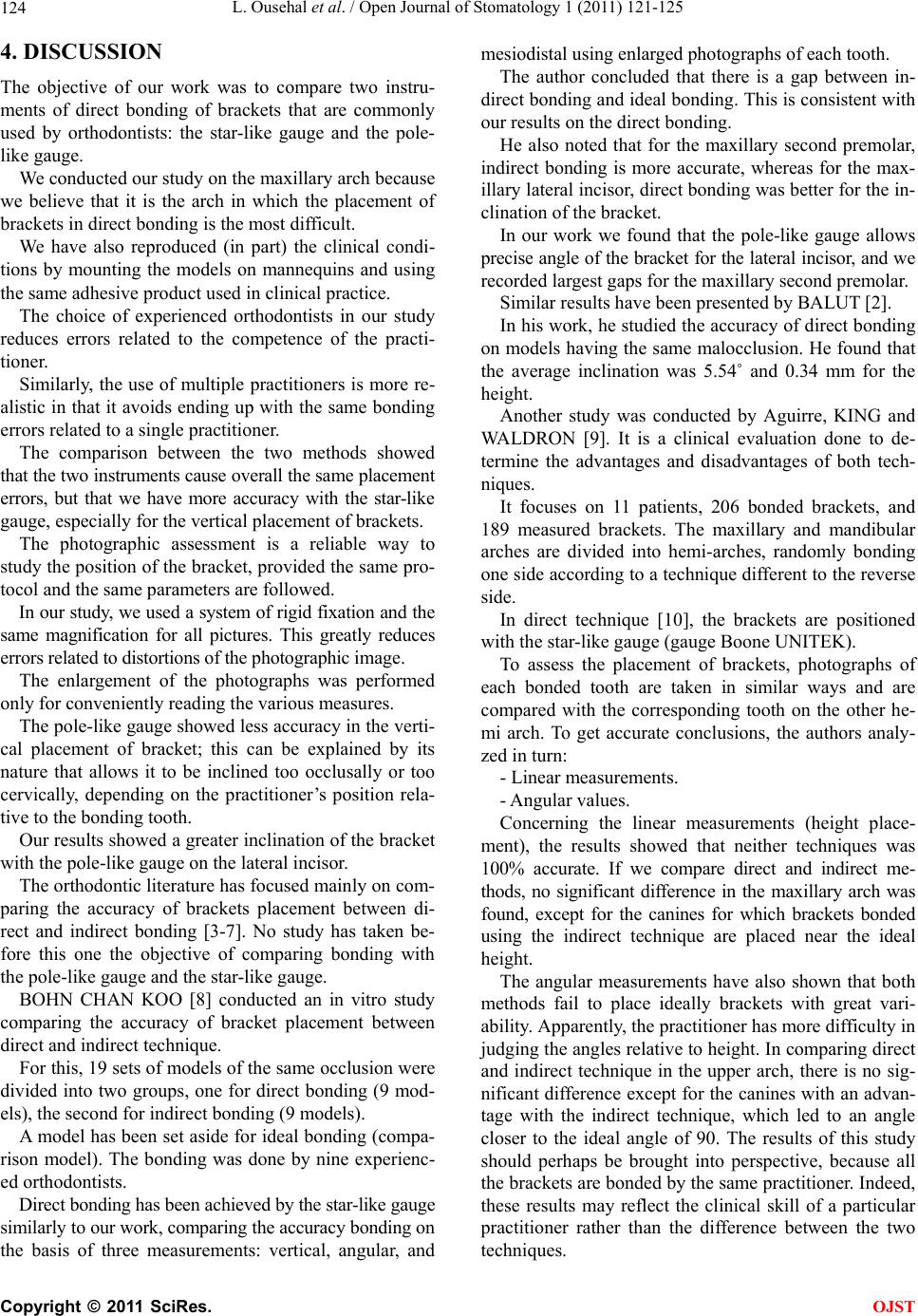
L. Ousehal et al. / Open Journal of Stomatology 1 (2011) 121-125
124
4. DISCUSSION
The objective of our work was to compare two instru-
ments of direct bonding of brackets that are commonly
used by orthodontists: the star-like gauge and the pole-
like gauge.
We conducted our study on the maxillary arch because
we believe that it is the arch in which the placement of
brackets in direct bonding is the most difficult.
We have also reproduced (in part) the clinical condi-
tions by mounting the models on mannequins and using
the same adhesive product used in clinical practice.
The choice of experienced orthodontists in our study
reduces errors related to the competence of the practi-
tioner.
Similarly, the use of multiple practitioners is more re-
alistic in that it avo ids ending up with th e same bonding
errors related to a single practitioner.
The comparison between the two methods showed
that the two ins truments cau se overall the same p lacemen t
errors, but that we have more accuracy with the star-like
gauge, especially for the vertical placement of brackets.
The photographic assessment is a reliable way to
study the position of the bracket, provided the same pro-
tocol and the same parameters are followed.
In our study, we used a system of rigid fixation and the
same magnification for all pictures. This greatly reduces
errors related to distortions of the phot ographic image.
The enlargement of the photographs was performed
only for conveniently reading the various measures.
The pole-like gauge sho wed less accuracy in the verti-
cal placement of bracket; this can be explained by its
nature that allows it to be inclined too occlusally or too
cervically, depending on the practitioner’s position rela-
tive to the bonding tooth.
Our results showed a greater inclination of the bracket
with the pole-like gauge on the lateral incisor.
The orthodontic literature has focu sed mainly o n com-
paring the accuracy of brackets placement between di-
rect and indirect bonding [3-7]. No study has taken be-
fore this one the objective of comparing bonding with
the pole-like gaug e and the star-like gauge.
BOHN CHAN KOO [8] conducted an in vitro study
comparing the accuracy of bracket placement between
direct and indirect technique.
For this, 19 sets of models of the same occlusion were
divided into two groups, one for direct bonding (9 mod-
els), the second for indirect bonding (9 models).
A model has been set aside for ideal bonding (compa-
rison model). The bonding was done by nine experienc-
ed orthodontists.
Direct bonding has been achieved by the st ar-like gauge
similarly to our work, comparing the accuracy bonding on
the basis of three measurements: vertical, angular, and
mesiodistal using enlarged photographs of each tooth.
The author concluded that there is a gap between in-
direct bonding and ideal bondin g. This is consistent with
our results on the direct bonding.
He also noted that for the maxillary second premolar,
indirect bonding is more accurate, whereas for the max-
illary lateral incisor, direct bonding was better for the in -
clination of the bracket.
In our work we found that the pole-like gauge allows
precise angle of the bracket for the la teral incisor, and we
recorded largest gaps for the maxillary second premolar.
Similar result s have been presented by B ALUT [2] .
In his work, he studied the accuracy of direct bonding
on models having the same malocclusion. He found that
the average inclination was 5.54˚ and 0.34 mm for the
height.
Another study was conducted by Aguirre, KING and
WALDRON [9]. It is a clinical evaluation done to de-
termine the advantages and disadvantages of both tech-
niques.
It focuses on 11 patients, 206 bonded brackets, and
189 measured brackets. The maxillary and mandibular
arches are divided into hemi-arches, randomly bonding
one side according to a technique different to the reverse
side.
In direct technique [10], the brackets are positioned
with the star-like gauge (gauge Boone UNITEK).
To assess the placement of brackets, photographs of
each bonded tooth are taken in similar ways and are
compared with the corresponding tooth on the other he-
mi arch. To get accurate conclusions, the authors analy-
zed in turn:
- Linear measurements.
- Angular values.
Concerning the linear measurements (height place-
ment), the results showed that neither techniques was
100% accurate. If we compare direct and indirect me-
thods, no significant difference in the maxillary arch was
found, except for the canines for which brackets bonded
using the indirect technique are placed near the ideal
height.
The angular measurements have also shown that both
methods fail to place ideally brackets with great vari-
ability. Apparently, the practitioner has more difficulty in
judging the ang les relative to height. In comparing direct
and indirect technique in the upper arch, there is no sig-
nificant difference except for the canines with an advan-
tage with the indirect technique, which led to an angle
closer to the ideal angle of 90. The results of this study
should perhaps be brought into perspective, because all
the brackets are bonded by the same practitioner. Indeed,
these results may reflect the clinical skill of a particular
practitioner rather than the difference between the two
techniques.
C
opyright © 2011 SciRes. OJST